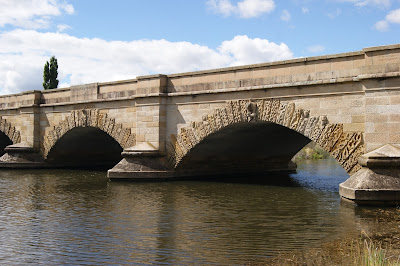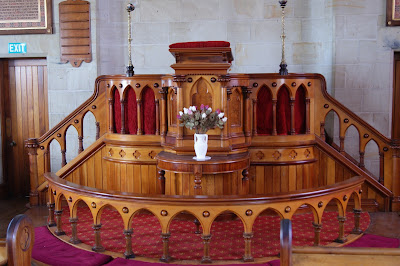First surveyed in 1807 by Government Surveyor Charles Grimes, who traced sections of the river. Governor Macquarie, inspired by the findings, visited in 1811 and named the area Argyle Plains and the river
In
1812 a garrison of soldiers was stationed at the ford of the Macquarie River Ross . Governor Macquarie called it Ross after the home of his
friend H.M. Buchanan who lived on Loch Lomond in Scotland Australia
The Macquarie
River Australia
Built by convicts
its beautiful stonework is the result of two convict stonemasons - Daniel
Herbert and James Colbeck. They were paid one shilling a day. Herbert, who had
been transported for highway robbery in 1827, was freed after the bridge was
completed and is buried in the Old
Cemetery Ross Bridge
The military presence remained an important part of Ross for many of its early years and its influence can still be seen today. A number of the early buildings around the town have military origins and several streets are named after battles of the Napoleonic wars. Some of the military stationed here in those early days were veterans of these campaigns. As Ross developed it became important not only as a garrison town but also as a coach horse change and livestock market. In 1826 it became the venue for the first agricultural show in the midlands. These beginnings are evident in the coaching inns and the fine properties in the surrounding district.
It also became the site of one of four Female Factories opened in
A road was needed between the North and South of the state. White
man had discovered the original aboriginal inhabitants had already carved trade
routes throughout the state. One such trade route was between the Launceston
district in the North and the "Hobart
Town Heritage Highway ". The best source
of labour to construct the road was convicts. The cheapest convicts to use
needed less supervision, so low security convicts were used. Places like Ross
were set up at river crossings along the route. The convicts could build and
maintain the road and river crossing (in this case the famous convict built
bridge).
The convicts also had to build the accommodation for themselves and
the officers in the village. As sandstone was more readily available than other
building materials, a lasting legacy of convict built sandstone buildings now
provide the visitor with an amazing experience. These early European settlers
aimed at recreating a familiar environment to them. It is no mistake that the
village is English in style complete with English Elms, cottage gardens and
quaint Georgian style cottages.
Throughout the nineteenth
century Ross was an important stopover point between Launceston and Hobart. As
such it was a horse coach changing point, a town for the local garrison and an
important destination for produce from the surrounding farms. The main
crossroad in Ross is known, with some humour, as Temptation, Recreation,
Salvation and Damnation. The reason for this combination is that on one corner
(Temptation) stood the Man-O-Ross Hotel, on another corner (Salvation) was the
Roman Catholic Church, on the third corner was the Town Hall (Recreation) and
on the fourth stood the Jail (Damnation).
The field gun in the middle of the crossroads was actually used during
the Boer War.
Today it is arguably the
finest nineteenth century village in Australia Wesleyan Church
The great quality of Ross is that it has not been overly
corrupted by modern tourism. The town is very typically English and, with its
warm Ross sandstone, is reminiscent of the towns which can be seen in the
Cotswolds or in north Oxfordshire. In many ways Ross is a town which has stopped
in time. It is beautifully preserved.


















